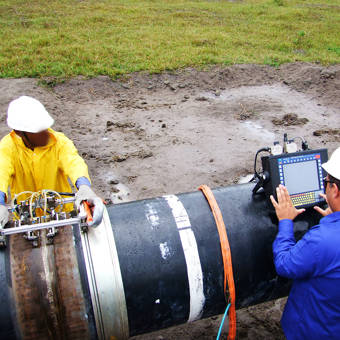Optimize Performance: Proactive Pipeline Welding Inspection Approaches
Optimize Performance: Proactive Pipeline Welding Inspection Approaches
Blog Article
Crucial Pipe Welding Inspection Tips for Quality Control
Just how can one ensure the quality of these welds that link the pipeline sections? By understanding the vital pipe welding inspection ideas, experts can prevent prospective dangers, minimize pricey repair work, and support the dependability of these essential facilities.

Significance of Welding Inspection
Welding examination plays a critical duty in ensuring the architectural honesty and security of pipeline systems. By meticulously checking out welds, assessors can identify any kind of flaws or flaws that might compromise the honesty of the pipe. These evaluations are vital for avoiding leakages, ruptures, and other possibly catastrophic failures that might cause environmental damage, monetary losses, and also loss of life.
The value of welding examination can not be overemphasized, as the top quality of welds straight impacts the general efficiency and long life of the pipe. Through non-destructive testing techniques such as visual assessment, ultrasonic screening, radiography, and magnetic fragment testing, inspectors can discover imperfections that might not show up to the naked eye. By determining and resolving these issues beforehand, welding inspection helps to ensure that pipelines meet industry standards and regulatory requirements.
Ultimately, welding evaluation is a vital aspect of quality control in pipeline upkeep, repair, and construction (Pipeline Welding Inspection). By maintaining extensive evaluation standards, sector experts can alleviate threats and promote the safety and security and dependability of pipeline systems
Usual Welding Flaws
Amongst the challenges faced in pipeline welding, usual problems can substantially impact the structural integrity and performance of the bonded joints. Cracks in the weld can circulate over time, compromising the architectural honesty of the pipeline. Finding and addressing these common defects with comprehensive inspection and high quality control procedures are essential for guaranteeing the dependability and security of pipe welds.
Assessment Strategies for Pipes

Non-destructive screening (NDT) methods such as radiographic screening, ultrasonic testing, magnetic bit testing, and liquid penetrant screening are typically made use of in pipeline welding assessment. Visual assessment is additionally vital in pipe welding to identify any kind of visible problems or discontinuities. Furthermore, computerized evaluation methods making use of innovative technologies like drones and robotics are increasingly being employed to improve the performance and accuracy of pipeline assessments.
Making Certain High Quality Assurance Requirements
To promote stringent quality assurance requirements in pipeline building and construction, precise adherence to developed market protocols and standards is necessary. Quality control in welding procedures requires a thorough technique encompassing different stages of pipeline building and construction. Making sure the top quality of welds includes using qualified welders, correct welding procedures, and adherence to market criteria such as those set by the American Petroleum Institute (API) and the American Society of Mechanical Designers (ASME) Examination and testing play a crucial duty in verifying the stability of welds, with techniques like non-destructive testing (NDT) being critical for discovering possible problems. In addition, maintaining comprehensive documents throughout the welding process is vital for traceability and top quality control purposes. Executing a durable top quality monitoring system that includes regular audits and evaluations can further boost the overall quality control criteria in pipe have a peek at this site welding. By focusing on adherence to these standards, stakeholders can ensure the dependability and security of pipe systems for the long-term.
Stopping Expensive Repair Work
Given the crucial importance of keeping rigorous quality control standards in pipeline building, a proactive approach to protecting against pricey repair services is vital. By executing comprehensive inspection methods throughout the welding process, possible problems can be identified and more helpful hints fixed early, inevitably conserving both money and time. One vital element of preventing pricey repair work is ensuring that welders are appropriately trained and accredited, as this considerably lowers the possibility of faulty welds that may lead to future failures. Furthermore, using advanced evaluation strategies such as non-destructive testing can assist spot any type of defects or variances in the welds prior to they escalate right into significant problems. Normal upkeep checks and monitoring of ecological factors that might influence the integrity of the pipeline are likewise crucial in stopping pricey repairs. By spending in preventative actions and prioritizing quality control at every stage of the pipeline welding process, companies can reduce the risk of expensive repair services and make certain the lasting dependability of their infrastructure.
Final Thought
In conclusion, adherence to dig this correct welding evaluation techniques is essential for making certain the high quality and stability of pipelines. By determining common welding issues and applying comprehensive examination processes, costly fixings can be protected against, and top quality assurance criteria can be satisfied - Pipeline Welding Inspection. It is critical for pipe welders to focus on examination procedures to maintain the security and dependability of the facilities they are working with
The importance of welding assessment can not be overemphasized, as the top quality of welds directly affects the general efficiency and durability of the pipeline. Non-destructive testing (NDT) methods such as radiographic screening, ultrasonic testing, magnetic bit screening, and liquid penetrant testing are typically made use of in pipeline welding assessment. Aesthetic examination is additionally essential in pipe welding to recognize any noticeable issues or interruptions. Additionally, computerized evaluation methods using sophisticated modern technologies like robotics and drones are significantly being used to boost the effectiveness and accuracy of pipeline evaluations.In final thought, adherence to proper welding assessment strategies is crucial for making sure the top quality and stability of pipes.
Report this page